By Arthur Woodgate
Writing about outside of Rye’s defence wall, it came to me that some of the property inside was not as antique as we might think. Yes there are footings all over where we can see buildings.I can remember quite a lot of old Rye being rebuilt or repaired or something quite new built on old sites. As money is a talking point let’s start with the banks. I haven’t many of the very old pictures of previous buildings that were at the bottom of West Street until Westminster and Lloyds banks decided to pull them down and build new premises, where they now are and have been for some years. I do remember a man who worked on the plastering of Lloyds and it would have been about one hundred years ago and Westminster would have been about the same time. Barclay’s was opposite, it was a converted old house in the high street which doesn’t look quite so old, but very sound. So we have a triage of modern banks at the bottom of West Street and there used to be a running joke, “Why is West Street like a river? Because it has a bank on each side.”
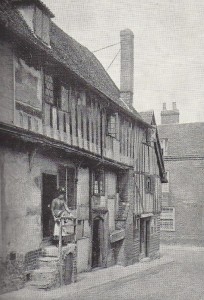
Miss Lucy Proctor lived at 11 High Street and it was turned into The Midland bank, and it was kept very much the same on the outside. Behind Lloyds bank was an old looking cottage which was bought by Miss Radciffe-Hall and Una Lady Trowbridge, they had the roof and three of the outside walls taken down and replaced but these parts were replaced to still look the same. Although almost brand new, I know because I was there.
My first experience with Radcliffe-Hall was on the corner of West Street where it joins Mermaid Street, the off-licence had its big chimney struck by lightning but one house half way down West Street has held on as an antique building.
I must explore Mermaid Street before I move on, The Oak Inn is still on the corner with a trader passage, and this was once the home of our Clerk Mr. Jeakes and his family, the town Clerk lived all over Mermaid Street at one time or another. The one I knew the most about was, which is now Jeake’s Hotel, is next door to the school I left when I was fourteen years of age in 1927. The Jeakes family at one time also owned the Old Hospital opposite. It looks so original that I think it must be called an antique.
I remember Humphrey Ellis, one time manager of Lloyds bank, when he lived at The Old Hospital, he was very good socially too, we scouts “Captain Cory’s Own” (1st Rye) were allowed to use his attic for several of our functions and the poor old building isn’t as rocky as it looked, it was quite steady. The Rye Town Bank used to practice in the school building which I went to, and Mr. Ellis used to send us in tumblers of tea.
This building certainly looks antique, Mermaid Street looks as if it could claim to be antique. Pieces have been added over the years. The adjoining building below the Mermaid had a pedestrian size “Go through” This was enlarged to a coach sized opening. I have often wondered how the coach drivers got their horses about. It has been used for smuggling both fictional (Dr. Syn) and for real, at one time it was bought by the Highwaymen. The Weston Brothers of Winchelsea members of the ‘Hawkhurst Gang’ who would sit in The Mermaid bar with their guns sitting on a table for all to see. There was just one bombed site after the Second World War, otherwise the streets of Mermaid Street remained a gem of antiquity.
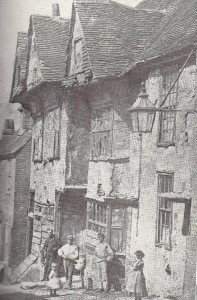
Now I am looking at the Lamb House area, (a mysterious part of the town). My mother was born in one of the back to front houses, on the short part of West Street opposite Lambs Cottage where it runs into Church Square. My mother, her parents or any of her siblings never said anything about her back to front house, but I did have a guess that Mermaid Street ran through what is the backs. Now the front door is just like an antique entrance from the back garden. Although a road and public footpath goes by, the public footpath was brought up and caused a step down into the house, it made it just right for visitors to look straight into Gran’s living room where she had a range with a revolving oven, this was where the old lady spent most of her time basting a joint of meat on the revolving oven. It annoyed her to see people staring in at her, but if any of us went in to see her just as she opened the oven it was a lovely smell greeting us and sometimes we stayed to share its taste. Grandma would shout rude remarks and tell them to “Hop it”, this room must still be there and it means a good deal to me, because if Grandad was home he would bring out games from a cupboard behind his chair and these included playing cards and snap. His favourite game was pass, so when his many Grandchildren were there cards were dealt and Grandad would shout PASS, so we all passed a card from left to right. When either of us found we had a pair of cards we scored a point, whilst this was going on he seemed younger than us children, although he had a Master Mariners certificate hanging on the wall behind him.
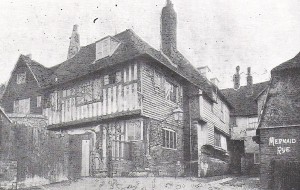
Two doors nearer the Church there was a shop belonging to a Miss Mollett and it sold anything to interest visitors, it was only one room per storey, and the firm I worked for then was invited to put another room on each of the three floors. In Tower House garden there was, and still is, a finished tower of 7 or 8 storeys. Theory has it that Miss Molletts shop used to be a pair to the other one and was built before Tower House with room to have Mermaid Street running between the two towers and joining Market Street.

In front of the Town Hall into the corner of Church Square we find a cottage called Mary’s Cottage. My great uncle Ted Batcheler lived there many years ago, he was one of Rye’s famous old pipe makers. A set of steps at the back led to a big garden and a “lean-to” along the back wall, here the pipes were laid out until the clay was dry enough to handle. My Great Uncle was also ships husband to some of Rye’s fishing fleet, so he did all the finance for my Grandad, (his brother). Beyond that was a vicarage, beyond that a row of cottages which together with the Town Hall formed the North side of Church Square, what a maze for a Town Centre?
I am beginning to forget some details, so if anybody can remember any puzzle of this area perhaps they could fill in what I can’t or anywhere else on the Old Town, not only in this corner but any other of our complicated zones. I’ll finish Church Square now I think.
On the east side of the Church and Town Hall is Pump Street, working out this street is easy, at least it is easier for me than Church Square. And it is easier to see why a pump and oval shaped reservoir are both right there on the corner of the Church yard. As a bricklayer the oval shaped brick water carrier is rather fascinating, I am not sure how old but I think it might be 16th Century or even older. It is very old and interesting and curious and worth talking about, there is not another one like it and it was lucky the German bombs did not touch it as lots of damage was done in that area. A house at the top of Mermaid Street was wrecked but hasn’t been rebuilt so there is an empty site in amongst ancient or even antique buildings all round it. The garden room in Lamb House garden went too but the reservoir was in more danger when houses close to the Gun Garden were destroyed, The Methodist Chapel was also wrecked. Damage was sustained just a few yards from the water storage. The Methodist Chapel was never rebuilt, but the Sunday School building was converted and is still used as the Chapel.
The Roof was blown off the Ypres Castle, This was replaced by a flat roof. A fund to restore the roof on the Lady Tower at the Castle is being raised at present. The south side of the Church Square had The Jolly Sailor pub in it, when the pub was open it was a very rough place to be. My father came to Rye in 1905, and in his first free time he went for a walk to see what sort of place he had come to work and live in. As he entered the south side of Church Square, The Jolly Sailor was busy, and he found himself in a very rough state after consumption of “Jolly Sailor” beer. He didn’t go there again for ages, and eventually the pub was shut down. Radcliffe-Hall came there to live and the place became quite a pleasant little square.
Let’s journey now towards the West and come to the very oldest house in the whole of the town!! It looked like a very old house and also like a friary. Not surprising, as the whole town belonged to the Monks for a long time. Some years back The BBC were interviewing people about that part of town and one of them said we have no one here who would have worked on Rye buildings and so they sent for me. I was asked about age and if they were 400 years old, I said they were standing on very old foundations but the houses themselves had been repaired and some nearly rebuilt lots of times. Some of the Oak Members had come from windmills and I recognised a piece of what had been the centre strut of what was This sort of information was not what was wanted!
So travelling along into Watch Bell Street, we come to the White House which has been renamed Swan House because Mr. Peter Swan of the International Manufacturing Firm lived there for many years. He is now dead. He had a big lawned garden on the opposite side of the road. When World War Two started he let Rye Borough Council build a public air raid shelter in there. Now there is a new house on the site, a very new house in an otherwise completely ancient street. The Catholic Church, St. Anthony of Padua, was built on the site of the original 1900 St Walburga’s. My father worked on it, so it’s another new building in a very old street. One of the houses in this street was an advanced dressing station by the Royal Army Medical Corps during the front line during the Battle Of Britain and afterwards. And the Watch House still there with bell holder and lookout intact looking towards Camber Castle and it’s little marsh and beside the Hope Anchor Hotel, which over time has had a couple of cottages built onto it, and lots of repairs done. The first day I started work on those cottages, the rain was pouring under the front door to the mat well, and it really was like a well when I got there as we had had a lot of rain around that time.
The door step stood well above and was a nine inch brick step, lots of examining had been made to see how to stop the rain driving in, and no way could be found, so it was decided to let it go in and then make way for it to come back out, so I was told to chop a round hole in the step with a pipe built in to let the water run back out. I think that is how it still is, the lookout was right by and what were known as the Green Steps that went down the cliff to The Strand.
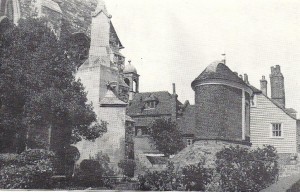
Whilst doing duty in this advanced dressing station with Doctor Button we heard a fighter in trouble so we went quickly to the lookout and there we saw a ‘Spitfire’ with full engine racing, spiralling down, we witnessed it ploughing itself into the ground. Ambulances were heading towards the crash scene, looking at the ambulance the Doctor said,”Waste of time, there is nought but twisted metal there”. There was not even that, it had buried itself and covered itself in. He was right, and that would have been 1940/41. It was a few years ago, say 2007 when it was reported the aircraft had been found, personal belongings were found with the pilot, so his family know, at last, where he crashed.
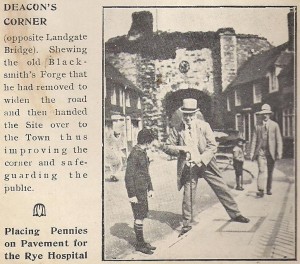
Now down trader passage to the bottom of Mermaid Street but think about the houses there, standing on others in the Strand, with little bridges to take them to their doors. So we had houses climbing across what was once The Borough Boundary, lots of these were destroyed by the Germans including Strand House. So I will be forgiven to hope to see some new development around the whole area, (it has) maybe, can mention this area in any future article.
Meanwhile we will go up the mint (as we call it, although it is part of the high street) stopping at Mint House, which was the home of Dr. Harratt and surgery later with Dr. Hartley. There used to be a row of houses in the grounds, which were demolished by the Germans together with part of a house called Faraday House and the lot of a police house the other side of the road. This part of town looks entirely different and I think will do. Away we go now, up the Mint till it becomes part of The High Street proper and so back to Lloyds Bank. There used to be a row of posh houses opposite, including a Woolworths and Boots, and I don’t suppose these two sites will hold private houses again. I remember when Woolworths was being created, the “Hue and Cry” against the Woolworth facia with its bright colours. Now there is dislike to Woolworths making room for the new library. From there to Hilder’s Cliff, bits and pieces have been done to the various buildings, in the case of ‘Boots’ so much was taken out that the whole building began to shake, one could see it spin and the man in charge got rather frightened and got the place quickly strutted up, now that’s not an antique building. Across the road again, at what was ‘Aden Coats’, the place then was in several overlapping parts, and I landed the job of re-roofing it. In the front it looked like a very good slate roof, we re-slated it though, as it butted into all sorts of levels and all sorts of corners, as there seemed to be two other properties. Aden Coats must have bought all three and made them act as one, it was one of the most difficult jobs in roofing but one of the most interesting jobs I had ever done, I did get it watertight and looking safe, but that is not an ancient place now. Radcliffe-Hall and Lady Trowbridge now came into play again, at The “Black Boy” which is no 4 High Street, we rebuilt lots of the inside, and inserted new windows. I was only 15 and had been in trouble with Radcliffe-Hall before several times until I got Una Lady Trowbridge on my side, and that was the last time I had much to do with the ladies.
Now I must double back to Rye’s oldest street, (Conduit Hill), it was the first place settlers landed when Rye was an Island. They put boulders down and built a Monastery just inside on the hill and found fresh water just outside the wall area, when the sea bed came so hard it became land. A pump in the building at the top of Rope Walk carried water in wooden pipes to the reservoir in the Church Yard, hence the name of Conduit. Monks took over and they had to earn a living which they did by making silk, they planted a row of mulberry trees right across the town. We in St. John bought a big house on Conduit hill opposite The Monastery, and although very old, I wouldn’t say ancient it was called “White Friars” and had a mulberry tree in its back garden. We had a few years of picking mulberries not to make silk but pick and sell the fruit for our funds, they are beautiful to eat.
Back to Market road, and leading out from it behind the High Street houses were traces of mulberry trees, I have no idea if any are left but the one at White Friars got destroyed one night because someone didn’t like its shape. Back in Market road there is a shop with a gable facing the street with a word “BESSIE” cut in it. I have seen that all my life and have wondered about it, it has just been refurbished but that name is still there. If there is anyone who knows about it, it would be rather good if we could be told something about its history. I’m sure it must be a hundred years old, unlike “Jarrett Close” (next door) which has just been built.
If anyone could say more or correct anything I have said, it would be excellent if they joined in.
Rye’s Own September 2012
All articles, photographs and drawings on this web site are World Copyright Protected. No reproduction for publication without prior arrangement. © World Copyright 2015 Cinque Ports Magazines Rye Ltd., Guinea Hall Lodge Sellindge TN25 6EG